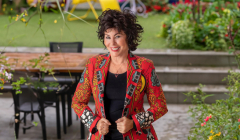
‘Being frazzled in the workplace has been dangerously normalised’
Comedian and actress Ruby Wax, Founder of mental health charity Frazzled, on taking stress seriously.

A panel discussion hosted by Disney looked at the progressive brands smashing stereotypes, creating room for conversations and shifting the visual language.

The commercial and creative imperative to move beyond outdated gender stereotypes and embrace diversity is not just good for society; it's business imperative. This was the focus of a panel hosted by Disney to examine how progressive brands are helping to usher in a new era of inclusive creativity.
Jacqui Bourke, Senior Manager Creative Insights at Getty Images, noted how quickly consumer expectations are shifting. “Sometimes, searches reflect the zeitgeist,” she explained, noting that in 2019 the image library has seen a 3,400% increase in searching for inclusion. Earlier this year Getty launched Project #ShowUs, the world’s largest photo library created by women and non-binary individuals to shatter beauty stereotypes. It's a campaign which has now grown to see the brand take aim at the stereotypes and lack of inclusion facing disabled people, both behind the lens and within advertising.
The panel agreed with the need to shift the visual language in the creative industries. But, as Will de Groot, Co-Founder of the Elephant Room and Founder of Mend, outlined, “There is a huge opportunity, but it’s all about purity of intent from a brand.”
The panel was moderated by BITE’s Managing Editor Nicola Kemp who articulated the problem when she said, “Business as usual becomes the perceived easiest thing to do.” When what actually needs to happen, according to Ali Hanan, Founder of Creative Equals, is that brands need to examine and “understand bias in your design thinking.”
This understanding needs to begin right back at the research stage, to enable the team to recognise “how bias permeates.” She gave the example of a toy brand tasking its teams with a brief to create toys for boys and, separate to that, toys for girls. It's a starting point which in effect embeds bias into the creative process from the outset.
The importance of having diversity behind the lens also topped the agenda. Hanan underlined the need to keep a laser focus on who’s telling the story in the first place. She explained, “diversity has to start with who makes the work. If you don’t have a diverse team, you’ll have blind spots.” She highlighted the statistic that progressive advertising is 25% more likely to be effective, particularly with a millennial audience, demonstrating the business imperative of creating diverse, representative work.
De Groot added that businesses “need to think about ROI in a cultural sense rather than purely commercial.” He believes that this authentic approach is key to making people feel included, noting that “ripple effect is something everyone feels; that’s inclusivity.”
The panel also addressed the ‘fear factor’ which often holds businesses and creatives back. Bourke noted that the reality is, businesses are “worried they’d get representation wrong.” Her response? “The way to counteract that is to have inclusive teams.”
Looks like you need to create a Creativebrief account to perform this action.
Create account Sign inLooks like you need to create a Creativebrief account to perform this action.
Create account Sign in